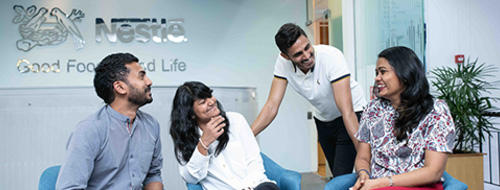
Coffee is fast becoming the beverage of choice among Sri Lankan millennials. Whether it’s quiet reflection in solitude, a good conversation with a colleague or catching-up with an old friend, many young adults prefer making these connections over a great cup of coffee. Ask them why and they’ll tell you it holds an aspirational appeal; sure, it tastes great, but it is also a social experience, a statement, a lifestyle choice.
Coffee drinkers are increasingly looking for greater choice, better quality, and simple convenience. For those who don’t have the time or inclination for brewing at home or visiting a café or vending machine, instant coffee is their go-to for instant refreshment.
The allure of instant coffee, very much a part of the lifestyle of young urban Sri Lankans, reflects its rich and innovative history.

Instant coffee (or soluble coffee) was introduced to the world in 1938, when Nescafé was launched on a crisp spring day in Switzerland. But its story actually starts a few years earlier, in 1929, when Nestlé was asked to find a solution to Brazil’s large supply of surplus coffee resulting from the Wall Street Crash. The ‘Banque Francaise et Italienne pour l’Amerique du Sud’ (The French and Italian Bank for South America) owned coffee beans in Brazil and were unable to sell it when coffee prices collapsed.
With the largest R&D network of any food company in the world, Nestlé accepted the challenge. After nine years of research and hard work, Nestlé’s lead scientist on the project, Max Morgenthaler, suddenly had a ‘Eureka!’ moment.

He invented a convenient soluble coffee powder that preserves the bean’s real aroma, but lasts a lot longer. As a result of his breakthrough work, Nestlé launched Nescafé in 1938. It took Switzerland by storm, and two short months later, the rest of the world followed.
Today Nescafé is the world’s number one coffee brand, enjoyed by half a billion people every day in over 180 countries. The best part? Nescafé is “au naturelle.” This means Nescafé is 100% coffee and made with natural coffee beans.
Continuing to innovate and stay on trend, Nescafé uses anthropologists, ethnographers and the best global and local market research organisations to understand how people love to enjoy their coffee. And crucially, it’s working hard to help coffee farmers grow quality beans sustainably under the Nescafé Plan.
Ultimately, the bank’s request wasn’t just the start of creating a brand new coffee experience; it was the start of a lasting relationship with coffee farmers and a pioneering future with coffee. So who better to bring people together on a day dedicated to celebrating coffee than Nescafé? On International Coffee Day, Nescafé is celebrating 80 years of sharing its love for coffee with delicious coffee recipes (Nescafé Cookie Crumble, Nescafé Chocca Mocca and Nescafé Affogato), to help young coffee-lovers everywhere connect with others and explore the quality and creativity of a delicious sustainable coffee.
So as you savour the rich taste of your favourite coffee, take the time to appreciate its rich history and how it has revolutionised the way you enjoy your coffee today.
